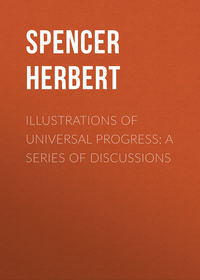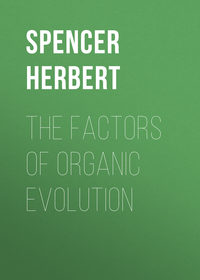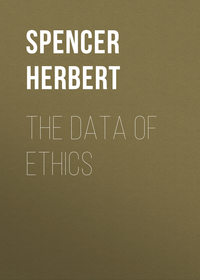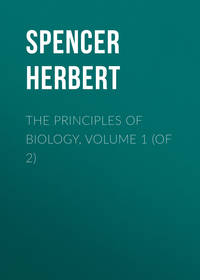 полная версия
полная версияFirst Principles
There is evidence also that modifications in the Earth’s crust due to igneous action have a certain periodicity. Volcanic eruptions are not continuous but intermittent, and as far as the data enable us to judge, have a certain average rate of recurrence; which rate of recurrence is complicated by rising into epochs of greater activity and falling into epochs of comparative quiescence. So too is it with earthquakes and the elevations or depressions caused by them. At the mouth of the Mississippi, the alternation of strata gives decisive proof of successive sinkings of the surface, that have taken place at tolerably equal intervals. Everywhere, in the extensive groups of conformable strata that imply small subsidences recurring with a certain average frequency, we see a rhythm in the action and reaction between the Earth’s crust and its molten contents – a rhythm compounded with those slower ones shown in the termination of groups of strata, and the commencement of other groups not conformable to them. There is even reason for suspecting a geological periodicity that is immensely slower and far wider in its effects; namely, an alternation of those vast upheavals and submergencies by which continents are produced where there were oceans, and oceans where there were continents. For supposing, as we may fairly do, that the Earth’s crust is throughout of tolerably equal thickness, it is manifest that such portions of it as become most depressed below the average level, must have their inner surfaces most exposed to the currents of molten matter circulating within, and will therefore undergo a larger amount of what may be called igneous denudation; while, conversely, the withdrawal of the inner surfaces from these currents where the Earth’s crust is most elevated, will cause a thickening more or less compensating the aqueous denudation going on externally. Hence those depressed areas over which the deepest oceans lie, being gradually thinned beneath and not covered by much sedimentary deposit above, will become areas of least resistance, and will then begin to yield to the upward pressure of the Earth’s contents; whence will result, throughout such areas, long-continued elevations, ceasing only when the reverse state of things has been brought about. Whether this speculation be well or ill founded, does not however affect the general conclusion. Apart from it we have sufficient evidence that geologic processes are rhythmical.
§ 96. Perhaps nowhere are the illustrations of rhythm so numerous and so manifest as among the phenomena of life. Plants do not, indeed, usually show us any decided periodicities, save those determined by day and night and by the seasons. But in animals we have a great variety of movements in which the alternation of opposite extremes goes on with all degrees of rapidity. The swallowing of food is effected by a wave of constriction passing along the œsophagus; its digestion is accompanied by a muscular action of the stomach that is also undulatory; and the peristaltic motion of the intestines is of like nature. The blood obtained from this food is propelled not in a uniform current but in pulses; and it is aerated by lungs that alternately contract and expand. All locomotion results from oscillating movements: even where it is apparently continuous, as in many minute forms, the microscope proves the vibration of cilia to be the agency by which the creature is moved smoothly forwards.
Primary rhythms of the organic actions are compounded with secondary ones of longer duration. These various modes of activity have their recurring periods of increase and decrease. We see this in the periodic need for food, and in the periodic need for repose. Each meal induces a more rapid rhythmic action of the digestive organs; the pulsation of the heart is accelerated; and the inspirations become more frequent. During sleep, on the contrary, these several movements slacken. So that in the course of the twenty-four hours, those small undulations of which the different kinds of organic action are constituted, undergo one long wave of increase and decrease, complicated with several minor waves. Experiments have shown that there are still slower rises and falls of functional activity. Waste and assimilation are not balanced by every meal, but one or other maintains for some time a slight excess; so that a person in ordinary health is found to undergo an increase and decrease of weight during recurring intervals of tolerable equality. Besides these regular periods there are still longer and comparatively irregular ones; namely, those alternations of greater and less vigour, which even healthy people experience. So inevitable are these oscillations that even men in training cannot be kept stationary at their highest power, but when they have reached it begin to retrograde. Further evidence of rhythm in the vital movements is furnished by invalids. Sundry disorders are named from the intermittent character of their symptoms. Even where the periodicity is not very marked, it is mostly traceable. Patients rarely if ever get uniformly worse; and convalescents have usually their days of partial relapse or of less decided advance.
Aggregates of living creatures illustrate the general truth in other ways. If each species of organism be regarded as a whole, it displays two kinds of rhythm. Life as it exists in all the members of such species, is an extremely complex kind of movement, more or less distinct from the kinds of movement which constitutes life in other species. In each individual of the species, this extremely complex kind of movement begins, rises to its climax, declines, and ceases in death. And every successive generation thus exhibits a wave of that peculiar activity characterizing the species as a whole. The other form of rhythm is to be traced in that variation of number which each tribe of animals and plants is ever undergoing. Throughout the unceasing conflict between the tendency of a species to increase and the antagonistic tendencies, there is never an equilibrium: one always predominates. In the case even of a cultivated plant or domesticated animal, where artificial means are used to maintain the supply at a uniform level, we still see that oscillations of abundance and scarcity cannot be avoided. And among the creatures uncared for by man, such oscillations are usually more marked. After a race of organisms has been greatly thinned by enemies or lack of food, its surviving members become more favourably circumstanced than usual. During the decline in their numbers their food has grown relatively more abundant; while their enemies have diminished from want of prey. The conditions thus remain for some time favourable to their increase; and they multiply rapidly. By and by their food is rendered relatively scarce, at the same time that their enemies have become more numerous; and the destroying influences being thus in excess, their number begins to diminish again. Yet one more rhythm, extremely slow in its action, may be traced in the phenomena of Life, contemplated under their most general aspect. The researches of palæontologists show, that there have been going on, during the vast period of which our sedimentary rocks bear record, successive changes of organic forms. Species have appeared, become abundant, and then disappeared. Genera, at first constituted of but few species, have for a time gone on growing more multiform; and then have begun to decline in the number of their subdivisions; leaving at last but one or two representatives, or none at all. During longer epochs whole orders have thus arisen, culminated, and dwindled away. And even those wider divisions containing many orders have similarly undergone a gradual rise, a high tide, and a long-continued ebb. The stalked Crinoidea, for example, which, during the carboniferous epoch, became abundant, have almost disappeared: only a single species being extant. Once a large family of molluscs, the Brachiopoda have now become rare. The shelled Cephalopods, at one time dominant among the inhabitants of the ocean, both in number of forms and of individuals, are in our day nearly extinct. And after an “age of reptiles,” there has come an age in which reptiles have been in great measure supplanted by mammals. Whether these vast rises and falls of different kinds of life ever undergo anything approaching to repetitions, (which they may possibly do in correspondence with those vast cycles of elevation and subsidence that produce continents and oceans,) it is sufficiently clear that Life on the Earth has not progressed uniformly, but in immense undulations.
§ 97. It is not manifest that the changes of consciousness are in any sense rhythmical. Yet here, too, analysis proves both that the mental state existing at any moment is not uniform, but is decomposable into rapid oscillations; and also that mental states pass through longer intervals of increasing and decreasing intensity.
Though while attending to any single sensation, or any group of related sensations constituting the consciousness of an object, we seem to remain for the time in a persistent and homogeneous condition of mind, a careful self-examination shows that this apparently unbroken mental state is in truth traversed by a number of minor states, in which various other sensations and perceptions are rapidly presented and disappear. From the admitted fact that thinking consists in the establishment of relations, it is a necessary corollary that the maintenance of consciousness in any one state to the entire exclusion of other states, would be a cessation of thought, that is, of consciousness. So that any seemingly continuous feeling, say of pressure, really consists of portions of that feeling perpetually recurring after the momentary intrusion of other feelings and ideas – quick thoughts concerning the place where it is felt, the external object producing it, its consequences, and other things suggested by association. Thus there is going on an extremely rapid departure from, and return to, that particular mental state which we regard as persistent. Besides the evidence of rhythm in consciousness which direct analysis thus affords, we may gather further evidence from the correlation between feeling and movement. Sensations and emotions expend themselves in producing muscular contractions. If a sensation or emotion were strictly continuous, there would be a continuous discharge along those motor nerves acted upon. But so far as experiments with artificial stimuli enable us to judge, a continuous discharge along the nerve leading to a muscle, does not contract it: a broken discharge is required – a rapid succession of shocks. Hence muscular contraction pre-supposes that rhythmic state of consciousness which direct observation discloses. A much more conspicuous rhythm, having longer waves, is seen during the outflow of emotion into dancing, poetry, and music. The current of mental energy that shows itself in these modes of bodily action, is not continuous, but falls into a succession of pulses. The measure of a dance is produced by the alternation of strong muscular contractions with weaker ones; and, save in measures of the simplest order such as are found among barbarians and children, this alternation is compounded with longer rises and falls in the degree of muscular excitement. Poetry is a form of speech which results when the emphasis is regularly recurrent; that is, when the muscular effort of pronunciation has definite periods of greater and less intensity – periods that are complicated with others of like nature answering to the successive verses. Music, in still more various ways, exemplifies the law. There are the recurring bars, in each of which there is a primary and a secondary beat. There is the alternate increase and decrease of muscular strain, implied by the ascents and descents to the higher and lower notes – ascents and descents composed of smaller waves, breaking the rises and falls of the larger ones, in a mode peculiar to each melody. And then we have, further, the alternation of piano and forte passages. That these several kinds of rhythm, characterizing æsthetic expression, are not, in the common sense of the word, artificial, but are intenser forms of an undulatory movement habitually generated by feeling in its bodily discharge, is shown by the fact that they are all traceable in ordinary speech; which in every sentence has its primary and secondary emphases, and its cadence containing a chief rise and fall complicated with subordinate rises and falls; and which is accompanied by a more or less oscillatory action of the limbs when the emotion is great. Still longer undulations may be observed by every one, in himself and in others, on occasions of extreme pleasure or extreme pain. Note, in the first place, that pain having its origin in bodily disorder, is nearly always perceptibly rhythmical. During hours in which it never actually ceases, it has its variations of intensity – fits or paroxysms; and then after these hours of suffering there usually come hours of comparative ease. Moral pain has the like smaller and larger waves. One possessed by intense grief does not utter continuous moans, or shed tears with an equable rapidity; but these signs of passion come in recurring bursts. Then after a time during which such stronger and weaker waves of emotion alternate, there comes a calm – a time of comparative deadness; to which again succeeds another interval, when dull sorrow rises afresh into acute anguish, with its series of paroxysms. Similarly in great delight, especially as manifested by children who have its display less under control, there are visible variations in the intensity of feeling shown – fits of laughter and dancing about, separated by pauses in which smiles, and other slight manifestations of pleasure, suffice to discharge the lessened excitement. Nor are there wanting evidences of mental undulations greater in length than any of these – undulations which take weeks, or months, or years, to complete themselves. We continually hear of moods which recur at intervals. Very many persons have their epochs of vivacity and depression. There are periods of industry following periods of idleness; and times at which particular subjects or tastes are cultivated with zeal, alternating with times at which they are neglected. Respecting which slow oscillations, the only qualification to be made is, that being affected by numerous influences, they are comparatively irregular.
§ 98. In nomadic societies the changes of place, determined as they usually are by exhaustion or failure of the supply of food, are periodic; and in many cases show a recurrence answering to the seasons. Each tribe that has become in some degree fixed in its locality, goes on increasing, till under the pressures of unsatisfied desires, there results migration of some part of it to a new region – a process repeated at intervals. From such excesses of population, and such successive waves of migration, come conflicts with other tribes; which are also increasing and tending to diffuse themselves. This antagonism, like all others, results not in an uniform motion, but in an intermittent one. War, exhaustion, recoil – peace, prosperity, and renewed aggression: – see here the alternation more or less discernible in the military activities of both savage and civilized nations. And irregular as is this rhythm, it is not more so than the different sizes of the societies, and the extremely involved causes of variation in their strengths, would lead us to anticipate.
Passing from external to internal changes, we meet with this backward and forward movement under many forms. In the currents of commerce it is especially conspicuous. Exchange during early times is almost wholly carried on at fairs, held at long intervals in the chief centres of population. The flux and reflux of people and commodities which each of these exhibits, becomes more frequent as national development leads to greater social activity. The more rapid rhythm of weekly markets begins to supersede the slow rhythm of fairs. And eventually the process of exchange becomes at certain places so active, as to bring about daily meetings of buyers and sellers – a daily wave of accumulation and distribution of cotton, or corn, or capital. If from exchange we turn to production and consumption, we see undulations, much longer indeed in their periods, but almost equally obvious. Supply and demand are never completely adapted to each other; but each of them from time to time in excess, leads presently to an excess of the other. Farmers who have one season produced wheat very abundantly, are disgusted with the consequent low price; and next season, sowing a much smaller quantity, bring to market a deficient crop; whence follows a converse effect. Consumption undergoes parallel undulations that need not be specified. The balancing of supplies between different districts, too, entails analogous oscillations. A place at which some necessary of life is scarce, becomes a place to which currents of it are set up from other places where it is relatively abundant; and these currents from all sides lead to a wave of accumulation where they meet – a glut: whence follows a recoil – a partial return of the currents. But the undulatory character of these actions is perhaps best seen in the rises and falls of prices. These, given in numerical measures which may be tabulated and reduced to diagrams, show us in the clearest manner how commercial movements are compounded of oscillations of various magnitudes. The price of consols or the price of wheat, as thus represented, is seen to undergo vast ascents and descents whose highest and lowest points are reached only in the course of years. These largest waves of variation are broken by others extending over periods of perhaps many months. On these again come others having a week or two’s duration. And were the changes marked in greater detail, we should have the smaller undulations that take place each day, and the still smaller ones which brokers telegraph from hour to hour. The whole outline would show a complication like that of a vast ocean-swell, on whose surface there rise large billows, which themselves bear waves of moderate size, covered by wavelets, that are roughened by a minute ripple. Similar diagrammatic representations of births, marriages, and deaths, of disease, of crime, of pauperism, exhibit involved conflicts of rhythmical motions throughout society under these several aspects.
There are like characteristics in social changes of a more complex kind. Both in England and among continental nations, the action and reaction of political progress have come to be generally recognized. Religion, besides its occasional revivals of smaller magnitude, has its long periods of exaltation and depression – generations of belief and self-mortification, following generations of indifference and laxity. There are poetical epochs, and epochs in which the sense of the beautiful seems almost dormant. Philosophy, after having been awhile predominant, lapses for a long season into neglect; and then again slowly revives. Each science has its eras of deductive reasoning, and its eras when attention is chiefly directed to collecting and colligating facts. And how in such minor but more obtrusive phenomena as those of fashion, there are ever going on oscillations from one extreme to the other, is a trite observation.
As may be foreseen, social rhythms well illustrate the irregularity that results from combination of many causes. Where the variations are those of one simple element in national life, as the supply of a particular commodity, we do indeed witness a return, after many involved movements, to a previous condition – the price may become what it was before: implying a like relative abundance. But where the action is one into which many factors enter, there is never a recurrence of exactly the same state. A political reaction never brings round just the old form of things. The rationalism of the present day differs widely from the rationalism of the last century. And though fashion from time to time revives extinct types of dress, these always re-appear with decided modifications.
§ 99. The universality of this principle suggests a question like that raised in foregoing cases. Rhythm being manifested in all forms of movement, we have reason to suspect that it is determined by some primordial condition to action in general. The tacit implication is that it is deducible from the persistence of force. This we shall find to be the fact.
When the prong of a tuning-fork is pulled on one side by the finger, a certain extra tension is produced among its cohering particles; which resist any force that draws them out of their state of equilibrium. As much force as the finger exerts in pulling the prong aside, so much opposing force is brought into play among the cohering particles. Hence, when the prong is liberated, it is urged back by a force equal to that used in deflecting it. When, therefore, the prong reaches its original position, the force impressed on it during its recoil, has generated in it a corresponding amount of momentum – an amount of momentum nearly equivalent, that is, to the force originally impressed (nearly, we must say, because a certain portion has gone in communicating motion to the air, and a certain other portion has been transformed into heat). This momentum carries the prong beyond the position of rest, nearly as far as it was originally drawn in the reverse direction; until at length, being gradually used up in producing an opposing tension among the particles, it is all lost. The opposing tension into which the expended momentum has been transformed, then generates a second recoil; and so on continually – the vibration eventually ceasing only because at each movement a certain amount of force goes in creating atmospheric and etherial undulations. Now it needs but to contemplate this repeated action and reaction, to see that it is, like every action and reaction, a consequence of the persistence of force. The force exerted by the finger in bending the prong cannot disappear. Under what form then does it exist? It exists under the form of that cohesive tension which it has generated among the particles. This cohesive tension cannot cease without an equivalent result. What is its equivalent result? The momentum generated in the prong while being carried back to its position of rest. This momentum too – what becomes of it? It must either continue as momentum, or produce some correlative force of equal amount. It cannot continue as momentum, since change of place is resisted by the cohesion of the parts; and thus it gradually disappears by being transformed into tension among these parts. This is re-transformed into the equivalent momentum; and so on continuously. If instead of motion that is directly antagonized by the cohesion of matter, we consider motion through space, the same truth presents itself under another form. Though here no opposing force seems at work, and therefore no cause of rhythm is apparent, yet its own accumulated momentum must eventually carry the moving body beyond the body attracting it; and so must become a force at variance with that which generated it. From this conflict, rhythm necessarily results as in the foregoing case. The force embodied as momentum in a given direction, cannot be destroyed; and if it eventually disappears, it re-appears in the reaction on the retarding body; which begins afresh to draw the now arrested mass back from its aphelion. The only conditions under which there could be absence of rhythm – the only conditions, that is, under which there could be a continuous motion through space in the same straight line for ever, would be the existence of an infinity void of everything but the moving body. And neither of these conditions can be represented in thought. Infinity is inconceivable; and so also is a motion which never had a commencement in some pre-existing source of power. Thus, then, rhythm is a necessary characteristic of all motion. Given the coexistence everywhere of antagonist forces – a postulate which, as we have seen, is necessitated by the form of our experience – and rhythm is an inevitable corollary from the persistence of force.
Hence, throughout that re-arrangement of parts which constitutes Evolution, we must nowhere expect to see the change from one position of things to another, effected by continuous movement in the same direction. Be it in that kind of Evolution which the inorganic creation presents, or in that presented by the organic creation, we shall everywhere find a periodicity of action and reaction – a backward and forward motion, of which progress is a differential result.









